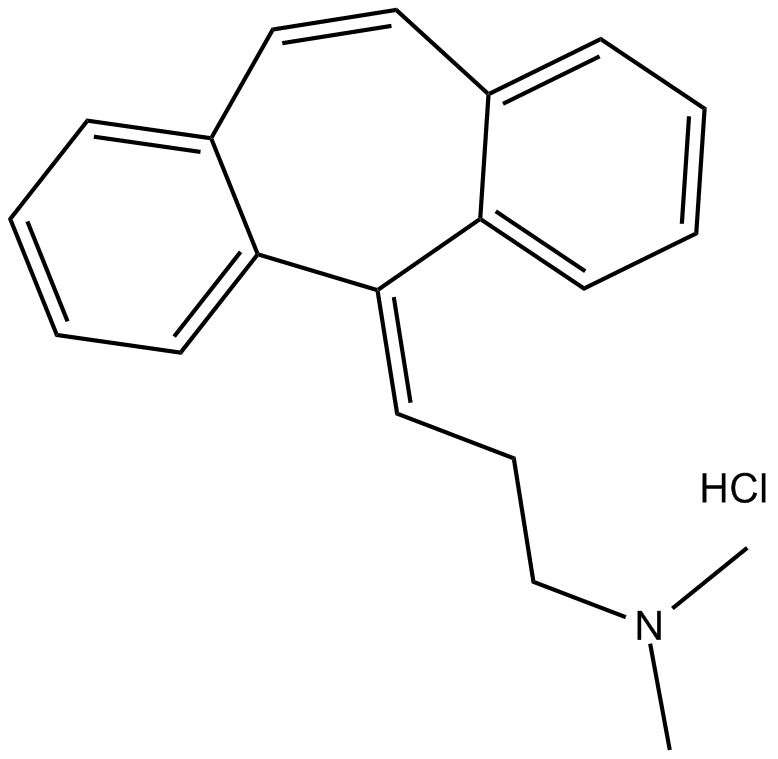Cyclobenzaprine HCl (Synonyms: MK-130) |
| رقم الكتالوجGC10743 |
Cyclobenzaprine HCl (MK130 hydrochloride) هو مرخي للعضلات الهيكلية ومثبط للجهاز العصبي المركزي (CNS).
Products are for research use only. Not for human use. We do not sell to patients.

Cas No.: 6202-23-9
Sample solution is provided at 25 µL, 10mM.
Cyclobenzaprine is a 5-HT2 receptor antagonist and inhibitor, in some article, cyclobenzaprine hydrochloride was used as the compound to research in cyclobenzaprine. Cyclobenzaprine inhibits the enhancement of the monosynaptic reflex (MSR) induced by 1-(2,5-dimethoxy-4-iodophenyl)-2-aminopropane (DOI). Cyclobenzaprine strongly binds to 5-HT2 receptors with a Ki value of 62 nM. Cyclobenzaprine binds to 5-HT1 receptor with a Ki value of 2900 nM [1] [2].
5-HT2 receptors are G-protein coupled. They comprise three subtypes that are related in their amino acid sequence, molecular structure and signaling properties: 5-HT2A, 5-HT2B and 5-HT2C receptors. With widespread distribution in the central nervous system, 5-HT2A and 5-HT2C receptors function there. In the central nervous system, 5-HT2B receptors are restrictedly expressed [3].
In 16 of 21 spontaneously active neurons, the administration of cyclobenzaprine at 1 mg/kg decreased the discharge rate of neurons, while two neurons showed no response and three neurons demonstrated an increased rate. The decrease amount varied widely but was always ≥ 25%. In three cases, the decrease amounts were 100%. In all cases, the cell response to cyclobenzaprine followed the MSR response very closely in time [2].
After DOI treatment in rats, treatment with cyclobenzaprine increased the mono- and polysynaptic reflex amplitudes to about 150% of control level. In intact (nonspinalized) rats, the amplitude of mono- and polysynaptic reflex potentials were significantly reduced by cyclobenzaprine hydrochloride (300 µg/kg, i.v.). Within 15 min after the administration of cyclobenzaprine, the maximum effect was obtained, and this effect persisted for over 60 min. The mono- and polysynaptic reflex amplitudes were inhibited by cyclobenzaprine by about 20% and 40%, respectively. In intact rats, the depression of the mono- and polysynaptic reflex potentials induced by cyclobenzaprine hydrochloride (300 µg/kg, i.v.) was significantly inhibited by 5-HT depletion. 15 min after the administration of cyclobenzaprine in control rats, the mono- and polysynaptic reflex amplitudes were reduced to about 40–50% of the preadministration value [1].
References:
[1]. Honda M, Nishida T, Ono H. Tricyclic analogs cyclobenzaprine, amitriptyline and cyproheptadine inhibit the spinal reflex transmission through 5-HT2 receptors. European journal of pharmacology, 2003, 458(1): 91-99.
[2]. Barnes C D, Fung S J, Gintautas J. Brainstem noradrenergic system depression by cyclobenzaprine. Neuropharmacology, 1980, 19(2): 221-224.
[3]. Leysen J E. 5-HT2 receptors. Current Drug Targets-CNS & Neurological Disorders, 2004, 3(1): 11-26.
Average Rating: 5 (Based on Reviews and 22 reference(s) in Google Scholar.)
GLPBIO products are for RESEARCH USE ONLY. Please make sure your review or question is research based.
Required fields are marked with *




















